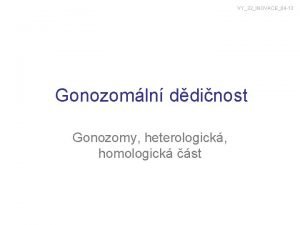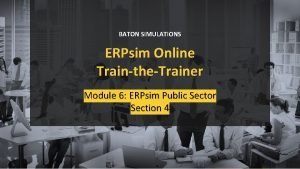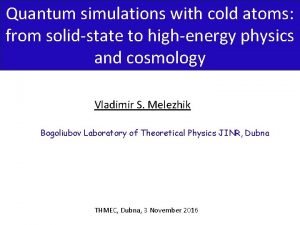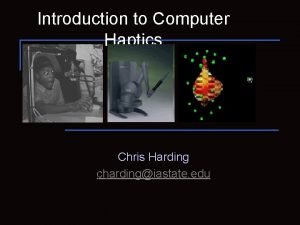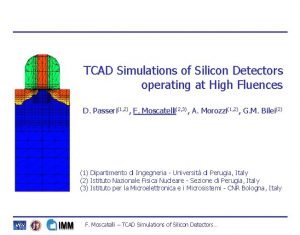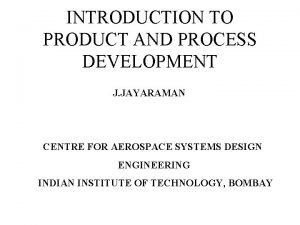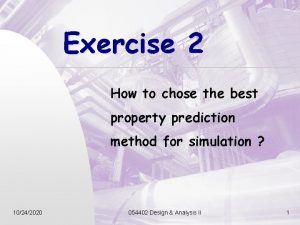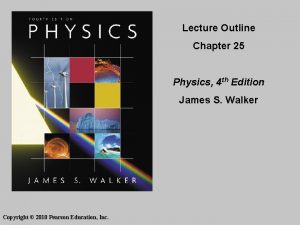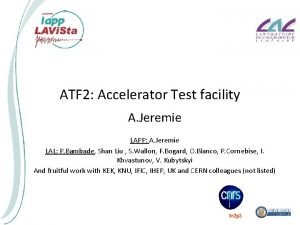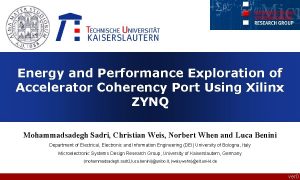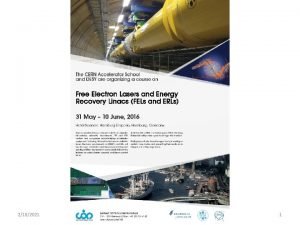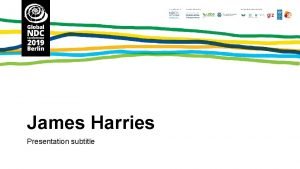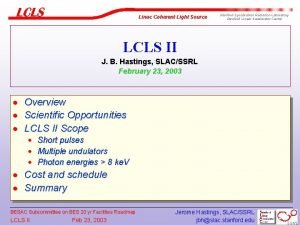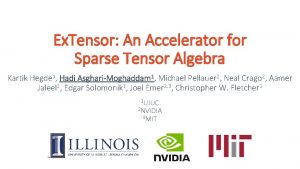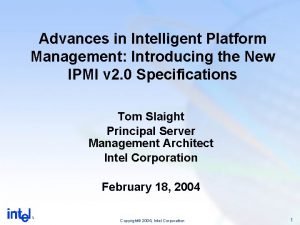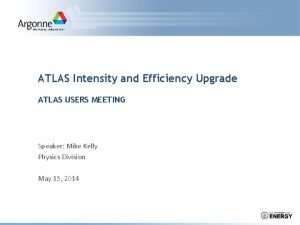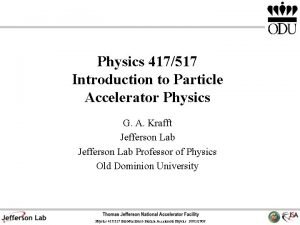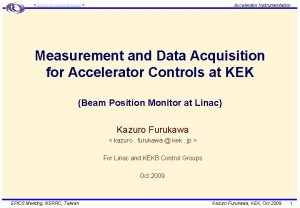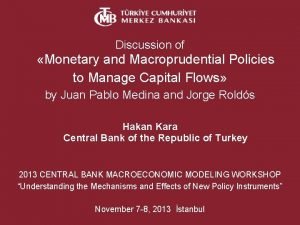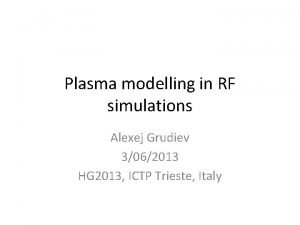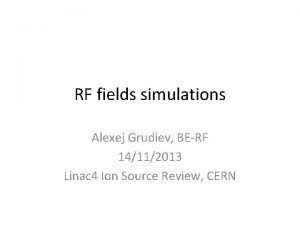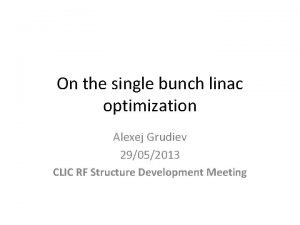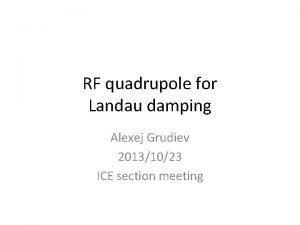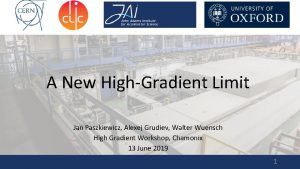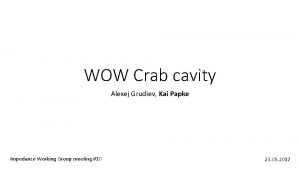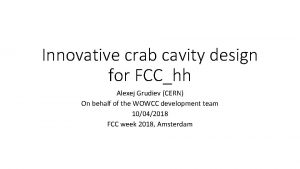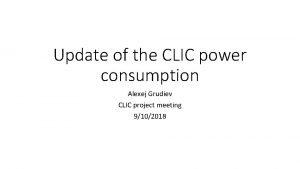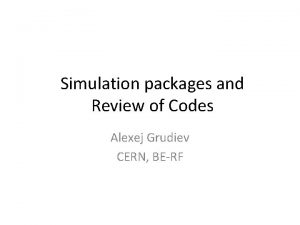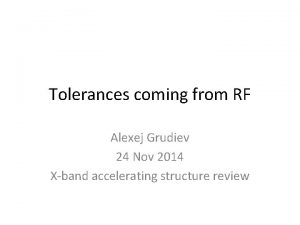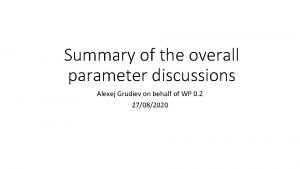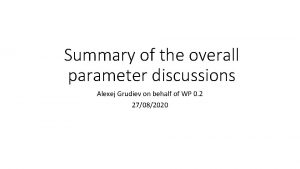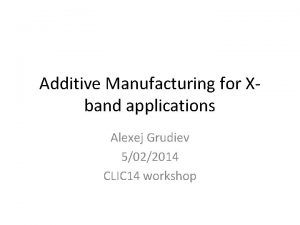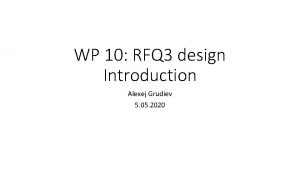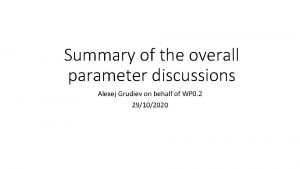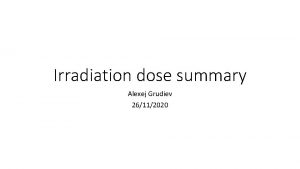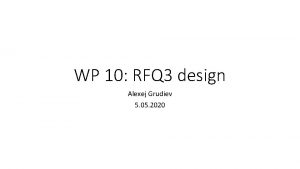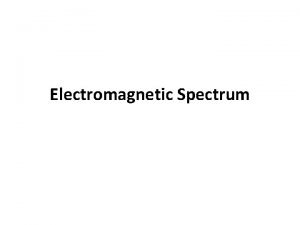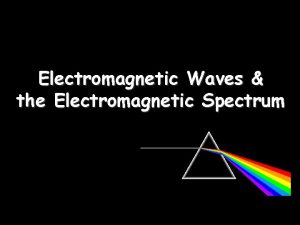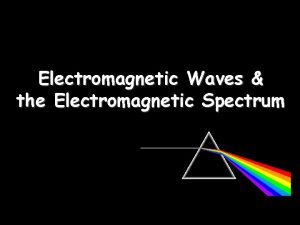Electromagnetic field simulations for accelerator optimization Alexej Grudiev






![Wx [V/p. C] CST (examples) Transverse wake at offset of 0. 5 mm Zx Wx [V/p. C] CST (examples) Transverse wake at offset of 0. 5 mm Zx](https://slidetodoc.com/presentation_image_h/8c38a5972398e98fbae481918672b575/image-7.jpg)



























- Slides: 34

Electromagnetic field simulations for accelerator optimization Alexej Grudiev CERN, BE-RF 1 st o. PAC Workshop: Grand Challenges in Accelerator Optimization, 26 -27 June 2013, CERN

Outline • A review of tools for electromagnetic field simulations used at CERN will be given. • A number of examples of its usage will be presented covering several areas of accelerator component design and optimization both RF and non-RF equipment: • accelerating cavities, • collimation devices, • etc. • A brief review of CLIC main linac RF frequency and accelerating gradient optimization will be given as an example of incorporating electromagnetic field simulation into a global optimization process including both • constraints coming from the beam dynamics simulations and • the empirical RF constraints related to the high gradient linac operation.

Packages for computer simulations of electromagnetic EM fields and more CST Gdfid. L HFSS ACE 3 P

CST Studio Suite CST STUDIO SUITE: - CST MWS - CST DS - CST EMS - CST PS - CST MPS - CST PCBS - CST CS - CST MICROSTRIPES - Antenna Magus

CST: All you need in one package • Powerful and user-friendly Input: • Probably the best time domain (TD) solver for wakefields or beam coupling impedance calculations (MAFIA) • Beta < 1 • Finite Conductivity walls • Once geometry input is done it can be used both for TD and FD simulations • Moreover using Design Studio (DS) it can be combined with the other studios for multiphysics and integrated electronics simulation, but this is relatively fresh fields of expertise for CST • Accelerator physics oriented post processor, especially in MWS and PS • Enormous progress over the last few years compared to the competitors. Courtesy of Igor Syratchev An example of what can be solved easily on a standard PC

CST (examples) Two examples of what can be solved on bigger PC: 128 GB of RAM and 24 CPUs CLIC accelerating structure from Cu with HOM damping loads from Si. C (frequency dependent lossy material) Giovanni De Michele
![Wx Vp C CST examples Transverse wake at offset of 0 5 mm Zx Wx [V/p. C] CST (examples) Transverse wake at offset of 0. 5 mm Zx](https://slidetodoc.com/presentation_image_h/8c38a5972398e98fbae481918672b575/image-7.jpg)
Wx [V/p. C] CST (examples) Transverse wake at offset of 0. 5 mm Zx [Ω] s [mm] Transverse beam couping impedance at offset of 0. 5 mm f [GHz]

CST (examples) LHC TDI 5 m long with ferrite Benoit Salvant

CST MWS: Example. S-parameters in CLIC Crab cavity Mesh view Praveen Ambattu

CST: Shortcomings 1. Cartesian mesh: Especially in FD can results to less accurate calculations of frequency, Q-factor, surface fields compared to tetrahedral mesh (HFSS, ACE 3 P). => if possible use tetrahedral mesh which became available recently and essentially gives the same results as FEM codes (HFSS, ACE 3 P). 2. Boundary conditions can be set only in Cartesian planes 3. No Field Calculator (HFSS) 4. .

HFSS: Still an excellent tool for FD High-Performance Electronic Design Ansoft Designer ANSYS HFSS ANSYS Q 3 D Extractor ANSYS SIwave ANSYS TPA Electromechanical Design ANSYS Multiphysics ANSYS Maxwell ANSYS Simplorer ANSYS PExprt ANSYS RMxprt Product options Ansoft. Links for ECAD Ansoft. Links for MCAD ANSYS Distributed Solve ANSYS Full-Wave SPICE ANSYS Optimetrics ANSYS Par. ICs • HFSS was and I think still is superior tool for FD simulations both S-pars and eigenmode, though CST shows significant progress in the recent years • Automatic generation and refinement of tetrahedral mesh • Most complete list of boundary conditions which can be applied on any surface • Ansoft Designer allows to co-simulate the pickup (antenna), cables plus electronics and together with versatile Optimetrics optimise the design of the whole device • Recently HFSS became an integral part of ANSYS – reference tool for thermo-mechanical simulations -> multiphysics • REcently time-dependent solver has been released

HFSS (examples, eigenmode) LHC TDI 5 m long beam dump: One of the most dangerous eigenmodes at 1. 227 GHz, Q = 873, Tetrahedral mesh with mixed order (0 th , 1 st , 2 nd) elements: Ntetr = 1404891 Solution obtained on a workstation with 128 GB of RAM,

HFSS (example, S-parameters) Incident plane wave excitation Port excitation O. Kononenko Inverse FFT

HFSS example

HFSS: shortcomings 1. No possibility to simulate particles 2. Automatic mesh is not always perfect, but it has improved after adoption by ANSYS 3. TD and multiphysics are only recently implemented, but thermo-mechanics from ANSYS is a reference by itself 4. .

Gdfid. L: Parallel and easy to use tool bruns@gdfidl. de The Gdfid. L Electromagnetic Field simulator Gdfid. L computes electromagnetic fields in 3 D-structures using parallel or scalar computers. Gdfid. L computes • Time dependent fields in lossfree or lossy structures. The fields may be excited by • port modes, • relativistic line charges. • Resonant fields in lossfree or lossy structures. • The postprocessor computes from these results eg. Scattering parameters, wake potentials, Q-values and shunt impedances. Features • Gdfid. L computes only in the field carrying parts of the computational volume. • Gdfid. L uses generalised diagonal fillings to approximate the material distribution. This reduces eg. the frequency error by about a factor of ten. • For eigenvalue computations, Gdfid. L allows periodic boundary conditions in all three cartesian directions simultaneously. • Gdfid. L runs on parallel and serial computers. Gdfid. L also runs on clusters of workstations. Availability • Gdfid. L only runs on UNIX-like operating systems.

Gdfid. L (example) CLIC accelerating structure from Cu with HOM damping loads from Si. C (frequency dependent properties)

Gdfid. L: shortcomings 1. Available only under UNIX-like systems 2. Geometry input is limited. Often other 3 D input tools have to be used. 3. .

ACE 3 P


waveguide ACE 3 P: example CLIC two-beam module rf circuit AS AS PETS Arno Candel et. al. , SLAC-PUB-14439

ACE 3 P: shortcomings • Very complex package to use. It is not userfriendly at all and requires a lots of time to invest before it can be used efficiently • It is not a commercial product -> no manual reference, limited tech support. No it is an open source. • . . .

Summary for the EM simulation tools 1. 2. CST Larger objects in TD Better FD calculations, 3 D EM + circuit co-simulation, RF + thermal + structural Gdfid. L ANSYS HFSS Accurate solution for very larger objects in TD and FD 3. ACE 3 P

CLIC main linac accelerating structure optimization. Brief Review of what was done back in 2007 Alexej Grudiev, CLIC main linac structure optimization.

General layout of CLIC at 3 Te. V More on CLIC : http: //clic-study. org/ Alexej Grudiev, CLIC main linac structure optimization.

Optimization procedure <Ea>, f, ∆φ, <a>, da, d 1, d 2 BD Bunch population N Ls, Nb Cell parameters Q, R/Q, vg, Es/Ea, Hs/Ea Structure parameters Ns Q 1 , A 1 , f 1 Bunch separation η, Pin, Esmax, ∆Tmax rf constraints NO Alexej Grudiev, CLIC main linac structure optimization. YES Cost function minimization BD

Optimization parameter space All structure parameters are variable: <Eacc> = 90 – 150 MV/m, f = 10 – 30 GHz, Δφ = 120 o, 150 o, <a>/λ= 0. 09 - 0. 21, Δa/<a> = 0. 01 – 0. 6, d 1/λ= 0. 025 - 0. 1, d 2 > d 1 Ls = 100 – 1000 mm. Alexej Grudiev, CLIC main linac structure optimization. N structures: 7 14 2 24 60 61 4 -------68. 866. 560

Structure parameter calculation From 3 D simulation (few hours) to an adequate model (few seconds) Dipole mode: Ns I N Fundamental mode: P(z) η, Pin, Esmax, ∆Tmax Alexej Grudiev, CLIC main linac structure optimization.

Cell parameter calculation Single cell parameter interpolation Q, R/Q, vg, Es/Ea, Hs/Ea a/λ 0. 7 d/λ 0. 1 0. 25 0. 4 WDS 2 cells Alexej Grudiev, CLIC main linac structure optimization. 1. 5 2. 3

Optimization constraints Beam dynamics (BD) constraints based on the simulation of the main linac, BDS and beam-beam collision at the IP: • N – bunch population depends on <a>/λ, Δa/<a>, f and <Ea> because of short-range wakes • Ns – bunch separation depends on the long-range dipole wake and is determined by the condition: Wt, 2 · N / Ea < 10 V/p. C/mm/m · 4 x 109 / 150 MV/m D. Schulte RF breakdown and pulsed surface heating (rf) constraints: • ΔTmax(Hsurfmax, tp) < 56 K Esurfmax < 380 MV/m • Pintp 1/3/Cin = 18 MW·ns 1/3/mm @ X-band • Alexej Grudiev, CLIC main linac structure optimization.

Optimizing Figure of Merit Luminosity per linac input power: Collision energy is constant Figure of Merit (Fo. M = ηLbx/N) Alexej Grudiev, CLIC main linac structure optimization.

Parametric Cost Model Total cost = Investment cost + Electricity cost for 10 years Ct = C i + C e Ci = Excel{fr; Ep; tp; Ea ; Ls ; f ; Δφ} Repetition frequency; Pulse energy; Pulse length; Accelerating gradient; Structure length (couplers included); Operating frequency; rf phase advance per cell Ce = (0. 1011+7. 1484/Fo. M)/12 [a. u. ] Figure of Merit (ηL/N) in a. u. (the same as before) [a. u. ]=[1 e 34/bx/m 2 • %/1 e 9] Hans Braun, 2006 Alexej Grudiev, CLIC main linac structure optimization.

CLIC performance and cost versus gradient Ecms = 3 Te. V Performance New Previous L(1%) = 2. 0 1034 cm-2 s-1 Cost New Optimum • Performance increases with lower accelerating gradient (mainly due to higher efficiency) • Flat cost variation in 100 to 130 MV/m with a minimum around 120 MV/m Alexej Grudiev, CLIC main linac structure optimization. Previous

CLIC performance and cost versus frequency Ecms = 3 Te. V L(1%) = 2. 0 1034 cm-2 s-1 Performance New Optimum Cost Previous New Optimum Previous • Maximum Performance around 14 GHz • Flat cost variation in 12 to 16 GHz frequency range with a minimum around 14 GHz Alexej Grudiev, CLIC main linac structure optimization.
 Alexej nikolajevič
Alexej nikolajevič World history simulations
World history simulations Baton simulations
Baton simulations Clinical simulations in nursing education
Clinical simulations in nursing education Simulations for solid state physics
Simulations for solid state physics Chris harding simulations
Chris harding simulations Www.irs.gov/app/understanding taxes/student/simulations.jsp
Www.irs.gov/app/understanding taxes/student/simulations.jsp Tcad simulations
Tcad simulations Pinpoint simulations 777
Pinpoint simulations 777 Don't gamble with physical properties for simulations
Don't gamble with physical properties for simulations Momentum of electromagnetic field
Momentum of electromagnetic field Field dependent vs field independent
Field dependent vs field independent Field dependent definition
Field dependent definition Field dependent vs field independent
Field dependent vs field independent Magnetic field
Magnetic field E field h field
E field h field Electric field and magnetic field difference
Electric field and magnetic field difference 21lwuy8i6hw -site:youtube.com
21lwuy8i6hw -site:youtube.com Database field types and field properties
Database field types and field properties Accelerator
Accelerator Accelerator coherency port
Accelerator coherency port Cern accelerator school 2021
Cern accelerator school 2021 Climate finance accelerator
Climate finance accelerator Linear accelerator stanford
Linear accelerator stanford Uplogix 500
Uplogix 500 Netbackup accelerator best practices
Netbackup accelerator best practices Extensor: an accelerator for sparse tensor algebra
Extensor: an accelerator for sparse tensor algebra Biztalk swift
Biztalk swift Intelligent systems corporation
Intelligent systems corporation Atlas accelerator module
Atlas accelerator module Physics
Physics Medical particle accelerator
Medical particle accelerator Asean graduate program
Asean graduate program Accelerator
Accelerator Financial accelerator
Financial accelerator
